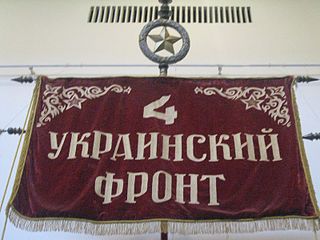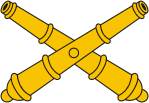The Southwestern Front was a front of the Red Army during the Second World War, formed thrice.

The 4th Ukrainian Front was the name of two distinct Red Army strategic army groups that fought on the Eastern Front in World War II.
The 85th Leningrad-Pavlovsk Red Banner Motor Rifle Division was an infantry division of the Soviet Red Army converted to a motorised formation in 1957. It was part of the Russian Ground Forces until it was reorganised as the 32nd Separate Motor Rifle Brigade in 2009. In 2016, the 32nd Separate Motor Rifle Brigade was reorganised as the 228th Motor Rifle Regiment of the 90th Guards Tank Division.
The 9th Bobruisk-Berlin Red Banner Order of Suvorov Tank Division was the designation of two separate formations of the Soviet Army. The original 9th Tank Division was formed in 1940 and later reorganized into a different division. During World War II, the Soviet Army formed the 9th Tank Corps, which was renamed the 9th Tank Division after the defeat of Germany in 1945. This second instance of the 9th Tank Division served with the Group of Soviet Forces in Germany from 1945 until about 1991, when it was disbanded.
The 12th Guards Uman Orders of Lenin Red Banner and Suvorov Tank Division was a tank division of the Soviet Ground Forces. It drew its history from the World War II 16th Tank Corps. It was redesignated successively as 12th Guards Tank Corps (1943) and 12th Guards Tank Division (1946).

The 28th Army was a field army of the Red Army and the Soviet Ground Forces, formed three times in 1941–42 and active during the postwar period for many years in the Belorussian Military District.
The 95th Rifle Division was a Red Army Rifle Division during World War II, formed three times. The division was first formed in November 1923 with the 6th Rifle Corps. It fought in the Winter War and the Soviet occupation of Bessarabia and Northern Bukovina. After Operation Barbarossa, the division fought in the retreat from Moldova and fought in the siege of Odessa and the siege of Sevastopol. It was destroyed during the siege of Sevastopol and was disbanded in late July 1942. The division was reformed in August 1942 from the 13th Motor Rifle Division NKVD and fought at the Battle of Stalingrad. For its actions during the battle, the division became the 75th Guards Rifle Division in March 1943. In April 1943, the division was formed a third time at Kaluga from the 121st Rifle Brigade. It fought in Operation Bagration.
The 266th Rifle Division was a rifle division of the Soviet Red Army during World War II. The 266th was formed three times during the war.
The 161st Stanislav Red Banner Order of Bohdan Khmelnytskyi Mechanised Brigade was a brigade of the Ukrainian Ground Forces from 1993 to 2003.

The 11th Guards Mechanized Brigade is a unit of the Armed Forces of Belarus based in Slonim. The 11th Guards Brigade traces its history back to the 1942 formation of the 6th Tank Corps of the Soviet Army during World War II.

The 5th Shock Army was a Red Army field army of World War II. The army was formed on 9 December 1942 by redesignating the 10th Reserve Army. The army was formed two times prior to this with neither formation lasting more than a month before being redesignated.

The 5th Guards Cavalry Division was a military unit in the Workers' and Peasants' Red Army of the Union of Soviet Socialist Republics in the Great Patriotic War.
The 34th Guards Artillery Division was an artillery division of the Soviet Ground Forces and the Russian Ground Forces. It was formed after the Second World War in Potsdam as the 34th Artillery Division and served there with the Group of Soviet Forces in Germany. In 1993 it inherited the honors of the disbanded 2nd Guards Artillery Division. The division withdrew to Mulino, Nizhny Novgorod Oblast, in 1994 and was disbanded in 2009.
The 347th Rifle Division began forming in mid-September 1941, as a Red Army rifle division, in the North Caucasus Military District. It was soon assigned to the 58th Army while both it and its Army continued to form up before entering combat in November, as part of the offensive that first liberated Rostov-on-Don. During the German summer offensive in 1942 the division retreated back into the Caucasus, fighting to defend the routes to the oil fields at Baku, until the German forces began to retreat after their defeat at Stalingrad. During 1943 and early 1944 it continued to serve in the southern part of the front, taking part in the liberation of Crimea, before being transferred to the Baltic States region, serving in Latvia and Lithuania for the duration of the war, compiling a distinguished record of service along the way. In 1946 it was reformed as a rifle brigade, and its several successor formations remained part of the Red Army until 1959, when it was finally disbanded.
The 1st Guards Glukhov Order of Lenin, Red Banner, Orders of Suvorov, Kutuzov, and Bogdan Khmelnitsky Breakthrough Artillery Division was the formal name of the 1st Guards Breakthrough Artillery Division, a division of the Red Army that existed during World War II and the early period of the Cold War. The division was formed under the reorganisation of the Soviet artillery forces in 1943, becoming an active heavy artillery formation during the Second World War. However, following cuts to the army in the later 50s, the division was disbanded.
The 1st Tank Division was a Division sized unit of the Red Army that existed from 1940–42. It was later reformed, from a separate formation, with a different lineage. Within the Soviet Ground Forces it existed as a second line ready division from 1945–2008, at Kaliningrad in the Baltic Military District.

642nd Cannon Artillery Regiment of the Reserve of the Main Command was a military formation of the Armed Forces of the Soviet Union that took part in the Great Patriotic War.
The 227th Rifle Division was an infantry division of the Red Army, originally formed in the months just before the start of the German invasion, based on the shtat of September 13, 1939. It arrived at the front in July and was assigned to 26th Army along the Dniepr, but was fortunate to escape that Army's encirclement in September. During the next several months, the division fought as part of 40th Army in the Kursk region, operating toward Prokhorovka and Oboyan during the winter counteroffensive. It made noteworthy gains during the May 1942 offensive north of Kharkiv but these went for naught when the southern wing of the offensive collapsed. When the main German summer offensive began in late June, the division's 21st Army was directly in the path of the German 6th Army and the depleted 227th was soon destroyed on the open steppes.
The 4th Artillery Berlin Red Banner Breakthrough Corps of the RGK — was a military formation, artillery breakthrough corps Reserve of the Supreme High Command of the Red Army during the Second World War.







